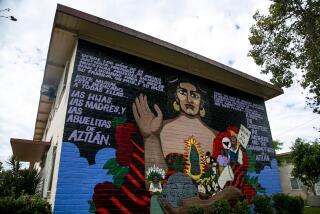Gangs’ Paper Trail : Magazines: Teen Angels prints graffiti, art, poetry and obituaries. Critics say it glorifies the lifestyle but doesn’t show the consequences.
- Share via
Local police have a new tool in their fight against Ventura County street gangs.
Teen Angels, a Rialto-based magazine that publishes gang graffiti, artwork, poetry and even obituaries, has become a primer for law enforcement officials who use it to spot trends among gang members and feature it in training courses and lectures.
Although Teen Angels prints anti-violence and anti-drug slogans, authorities say the magazine glorifies street gangs and their violent lifestyle.
“Gangs use it to advertise their philosophy,” said Ventura County Sheriff’s Detective Bill Stevens, who reads the magazine to keep up on the latest gang trends.
“Most gangs are looking for recognition,” he said. “It’s a badge of honor to have your gang in the magazine.”
The magazine lets readers speak for themselves.
“We don’t overtly preach to the kids,” said a Teen Angels employee who asked not to be identified. “They get enough of that from their parents, teachers and the church.”
The magazine caters to minorities, said Antonio Beltran, 21, an inmate at the California Youth Authority’s Ventura School in Camarillo. “We get to speak and they print it.”
With its eye-catching drawings of beautiful Latinas and customized cars, Teen Angels offers aspiring young artists a chance to publish their artwork, readers say.
But some say the glamorous pictures don’t reveal the harsh consequences of gang life. “It presents a falsehood that everything is cool,” said Lonnie Miramontes, director of community services for El Concilio del Condado de Ventura, a Latino-rights advocacy group in Oxnard.
Although Teen Angels is banned at the Ventura School, inmates are allowed to have illustrations from the magazine that are not gang-related. They use the drawings as models to inscribe pictures into plastic cups. Shoe polish is rubbed into the grooves to highlight the pattern.
A program coordinator at Ventura’s Westpark Community Center uses the magazine’s Old English-style lettering and drawings to attract youngsters to after-school recreation programs.
Teen Angels is also known as a way to meet companions, swap news and compare art and clothing styles.
The magazine is one of the few links to the outside world for some lonely inmates at many state institutions.
Inmates like pen pals, said 21-year-old Carlo Diaz of Ventura, who says he has acquaintances in the CYA. “They’re on top of the world when somebody writes to them. Especially if they don’t know them.”
Filled with group photos and obituaries of gang members, Teen Angels has become a keepsake album for many incarcerated readers, reminding them of happier times.
“It brings a lot of memories that can bring a lot of uplift,” said Soloman Adegbenro, a 19-year-old Ventura School inmate. “To see themselves printed on paper--that’s forever.”
Teen Angels also discusses topics such as relationships, teen-age pregnancy and abortion in a no-nonsense manner readers easily understand.
“It covers issues young people are dealing with in a way that we can relate to,” said Adegbenro, who recalls one issue that featured a list of affordable women’s health clinics. “It’s something more accepted in our lifestyle.”
Despite the Ventura School ban on the magazine, inmates nonetheless claim it as their own. They say the magazine does not promote violence, but merely depicts the reality of the streets.
“It’s an outlet,” said James Blair of Woodland Hills, an 18-year-old inmate. “They just show people the way they are.”
The magazine, which sells for $6.95 and is published every two months, originated in East Los Angeles and spread to other predominantly Latino neighborhoods, said Bob Contreras, a detective with the Los Angeles Police Department.
An employee who answered the telephone last week at a number listed in the magazine refused to identify the publisher, saying he would respond only to mail inquiries. However, a previous letter was not answered.
The magazine began as a correspondence network for jail inmates and quickly became popular among gang members, said Sgt. Joe Guzman of the Los Angeles County Sheriff’s Department, who has lectured on gangs nationwide.
Since its debut in June, 1982, the publication has attracted other subscribers as well: law enforcement officials eager to stem the growing tide of gang members.
Investigators use Teen Angels in training courses and seminars as an up-to-date guide on gang clothing, hair and slang. They also use the publication to verify information on suspected gang members, and even to help convict them.
Santa Paula Police Sgt. George M. Brink, for example, used the publication to build evidence against four youths who were later convicted of stabbings and drive-by shootings.
“It’s another indicator he’s lying,” Brink said of one of the youths who denied being a gang member in court, but whose picture was published in the magazine. “You want to build a good, solid case.”
Law enforcement officials say the publication perpetuates gang activity, since readers send in pictures with the names and faces of rival gang members crossed out.
“It desensitizes them to violence,” said Ventura County’s Stevens, who has discovered the magazine in the possession of 13-year-olds. “It reinforces the notion of hating someone because of the neighborhood they come from.”
Orange County Sheriff’s Deputy Johnny Ortega said Teen Angels has published graffiti depicting crossed-out gang names beside the number 187--police terminology for homicide.
In January, gang fights erupted between Chiques Trece and Colonia Chiques after the magazine published a drawing showing the Colonia Chiques’ name crossed out, said a gang analyst with the Oxnard Police Department.
In the past five years, gangs and gang-related violence have increased dramatically. Police estimate that there are more than 2,000 gang members in Ventura County and more than 107,000 gang members in Los Angeles County.
The magazine does not show the harsh side of gang life, said Miramontes of El Concilio del Condado. “The mentality of Teen Angels and Low Riders,” a car magazine, “is to keep people stupid,” he said.
Teen Angels is “more detrimental than drugs because it shapes what future generations are going to think,” he said.
But some detectives and community activists say critics are overlooking the benefits of the magazine, which encourages gang members to put their graffiti on paper rather than on someone else’s property.
“I’d rather see it in a magazine than on a wall,” said Ventura County Sheriff’s Detective Jeff Matson. “It’s kind of trendy, and there’s no better stylized pictures and drawings than in that magazine.”
Roberta Payan, a program coordinator at Ventura’s Westpark Community Center, said the magazine is no more harmful than violent films or television programs.
“I used to read Teen Angels and Low Riders and I didn’t rush out to kill anybody,” said Payan, a former member of the Ventura Avenue Gangsters.
Payan said Teen Angels offers youngsters a glimpse of their counterparts from across the nation.
“I think they like to see kids who look like them or dress like them,” Payan said. “I have a soft spot in my heart for kids who like that lifestyle.”
Teen Angels is not gang-oriented but Latino-oriented, said Deputy Sheriff Ortega, who used to read the publication as a youngster in Santa Ana.
“Not all Hispanics are gang members,” Ortega said. “They might like the art. I liked the art.”
The magazine is popular not only among Latinos, but also among African-Americans and Anglos, the magazine employee said. An upcoming issue will feature a color centerfold of flags representing Teen Angels’ readers who hail from California, the southwestern United States, Mexico, El Salvador, Guatemala, Honduras, Guam, Samoa, Hawaii and Fiji.
But Payan said Teen Angels should more closely monitor its editorial content to avoid misleading impressionable readers.
“I don’t think it’s a good idea in any culture to see kids posing for pictures with a nine-millimeter gun,” Payan said. “They should be more conscious about the messages kids are trying to get across in their poetry and drawings.”
For some readers, debate over the magazine is irrelevant. At the Westpark Community Center, 19-year-old Greg Dominguez silently ponders a graffiti-filled page in Teen Angels.
“If the magazine was gone,” he concludes, “gangs would still be here.”
More to Read
Sign up for Essential California
The most important California stories and recommendations in your inbox every morning.
You may occasionally receive promotional content from the Los Angeles Times.










